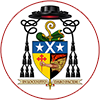Work has been slowly progressing on the re-building of our Lodge, former dwelling of Helen Grant RIP. Our builder Colin Thomson had completed the concrete shell of what had been Helen’s living room. Then in early February this year he was making final preparations before the Joiners came in to set up new timbers for the roof. To his great surprise, tucked away in a corner between the back (East) wall and the old roof timbers, over what had once been the back door, he found a pair of shoes. The shoes are iron shod, but tiny: around six and a half inches long; clearly made for a child. They must have been passed down through a succession of many children, because they are heavily worn down. The leather has been repaired in various places. In the heels even the iron is quite worn away.
The shoes are old: we thought surely from the Victorian era? The Lodge was built in 1820 by James Duff, 4th Earl of Fife. So we wondered: could they even be as old as that?
A news post on this web site soon elicited the helpful information that concealing shoes in houses - especially worn children’s shoes - is a well-documented folk custom, found all over Great Britain, and appearing also in America, Canada, Australia and New Zealand. Our attention was drawn to a 2019 article about this on the web site of the National Museum of Scotland in Edinburgh: “Hiding a shoe within the house has been a superstitious practice for centuries, but why?” https://blog.nms.ac.uk/author/molly-lambourne/
That article in turn directed us to the Northampton Museums & Art Gallery, which holds a collection of some 15,000 shoes, of which some 3,000 have emerged from hiding places in old houses. The Northampton Museum has a special Shoe Curator, whom we contacted, sending our photographs and description. While acknowledging that the shoes could have been shoved into place at more or less any time, she gave her professional opinion that our Lodge shoes would have been made in the early 19th century: maybe between 1800 and 1815. It’s a remarkable thought that maybe the uncle or father or older brother of the wearers of these shoes could have fought in the wars against Napoleon: as did Duff himself.
See: https://www.northamptonmuseums.com/info/3/collections/61/shoes-2?categoryID=3&documentID=61
Nobody seems to know the origin of this rather strange custom. Perhaps it was thought that well-worn children’s shoes could act as a charm to bring desired fertility? Or perhaps their presence would help ward off the attacks of witches or fairies? Or probably no one much thought of the remote origins of the custom, but simply did what was commonly thought to bring good luck?
Any Catholic would certainly sympathise with the desire to invoke blessing on a family home, or to ward off harm. But we would regard the hiding of old shoes for that purpose as nothing but foolish superstition. Much better to make use of the sacramental and intercessory power of the Church! So according to healthy Catholic instinct, a specially blessed medal, for example a medal of St. Benedict, or a Miraculous Medal, is still often placed in the foundations of a new building. Or again: one of the promises received by St. Margaret Mary Alacoque was that blessing would come to any house that displayed a picture of the Sacred Heart of Jesus. Also: any house can be specially blessed - or if necessary exorcised - by a Catholic Priest. In some places the old custom of an annual Epiphany blessing for houses still endures. Special Epiphany water is sprinkled, and specially blessed Epiphany chalk is used to write above a lintel “C.M.B.” The letters could stand for the names of the 3 Wise men – Caspar, Melchior and Balthasar – or they could stand for the prayer “Christus mansionem benedicat” – “May Christ bless our home.”
Here at Pluscarden our custom (not a foolish superstition!) is to bless our whole house twice a year. On the First Sunday of Advent, and on Easter Day, a Priest and Acolyte with holy water go from place to place, reciting special prayers for each: for the library, the dormitory, the kitchen, the refectory, the infirmary, the store rooms, the Guest houses, the Chapter House, the sacristy, and the Church, both outside and in.
While he’s at it, our monastic Priest will normally also bless our Lodge as he passes en route to St. Scholastica’s. May such a blessing, and others beside, truly preserve this house from harm, and bring blessing on all who stay in it.

